Sustainable Integration of a Solar Heating System into a Single-Family House in the Climate of Central Europe—A Case Study
Abstract
:1. Introduction
1.1. Integration of Solar Collectors and the Photovoltaic Thermal Solar Collector (PVT)
1.2. Integration of Heat Accumulators
- Section 2 describes the selection of the main components of the system in the form of a solar collector and a heat accumulator.
- Section 3 describes the possibilities of integrating the collector with a bed storage and a building. The criteria of assessing the integration method are then introduced and refer to its impact on architecture and functionality.
- Section 4 describes the influence of the location of the system on the energy performance of the building. Energy analyses of the solar heating system operation over the year are then presented for the three extreme variants of integration. It allows the exact dimensions of the system to be chosen and visualizations of real buildings to be created.
2. Materials and Methods
2.1. Solar Collectors—Selection of the Type of Collector
2.2. Rock Bed Storage—Selection of Filling Material
3. The Impact of Integration on the Architecture and Functionality of a Building
3.1. Integration of the Solar Collector with the Building
3.2. Assessment of the Integration of the Solar Concentrating Collector with the Building
3.3. Integration of the Bed Storage with the Building
3.4. Evaluation of the Integration of the Bed Storage with the Building
3.5. Selection of the Variant of the Integration for Further Analysis
- Variant No. 1—an object with a solar system adapted to the parameters of a typical single-family house. It includes a variant of the collector and the bed storage that are largely integrated with the building, as shown in Figure 7d and Figure 13d, called the enfilade house (Figure 17a). Such a location of the bed storage gives the greatest opportunities to use heat losses from the system. The added area with a solar collector does not limit the functionality of the facility.
4. Results and Discussion
The Final Appearance of Buildings with an Integrated Heating System
5. Conclusions
- The conducted analysis of the integration shows that the location of the heating system, apart from its influence on architecture and functionality, also strongly affects the operation and energy balance of the entire building.
- There is no universal variant of integrating the system with a new or existing building. However, the highest degree of integration can be obtained for objects that are in the design phase. It is possible to fully use and reduce heat losses from the system, while at the same time keeping the smallest sizes of solar collector and heat accumulator.
- Variant 1, in which the bed storage is located inside the building, was characterized by the covering of the heating demands with heat losses from the bed storage at the level of about 80%. In variant 2, in which the bed storage was placed in the corner of the building, the covering of the heating demands by heat losses from the bed storage was equal to about 60%, and in the last variant, in which the bed storage was placed next to the building, by about 25%.
- Analyses have shown that the degree of integration of this system with the building’s body determines the size and power of the installation. This allows the authors to state that the presented installation can be used in climatic conditions similar to Poland.
Author Contributions
Funding
Conflicts of Interest
References
- Solar Heat Europe. Available online: http://solarheateurope.eu (accessed on 24 June 2019).
- REN21. Renewables 2019 Global Status Report (Paris: REN21 Secretariat); REN21: Paris, France, 2019; ISBN 978-3-9818911-7-1. [Google Scholar]
- Benemann, J.; Chehab, O.; Schaar-Gabriel, E. Building-integrated PV modules. Solar Energy Mater. Solar Cells 2001, 67, 345–354. [Google Scholar] [CrossRef]
- Benemann, J.; Fitzgerald, M.C.; McCabe, J. Adv. Sol. Energy 1999, 13, 317.
- Hu, Z.; He, W.; Ji, J.; Zhang, S. A review on the application of Trombe wall system in buildings. Renew. Sustain. Energy Rev. 2017, 70, 976–987. [Google Scholar] [CrossRef]
- Bellos, E.; Tzivanidis, C.; Zisopoulou, E.; Mitsopoulos, G.; Antonopoulos, K.A. An innovative Trombe wall as a passive heating system for a building in Athens—A comparison with the conventional Trombe wall and the insulated wall. Energy Build. 2016, 133, 754–769. [Google Scholar] [CrossRef]
- Elinwa, U.K.; Radmehr, M.; Ogbeba, J.E. Alternative Energy Solutions Using BIPV in Apartment Buildings of Developing Countries: A Case Study of North Cyprus. Sustainability 2017, 9, 1414. [Google Scholar] [CrossRef]
- Ghosh, A.; Norton, B. Advances in switchable and highly insulating autonomous (self-powered) glazing systems for adaptive low energy buildings. Renew. Energy 2018, 126, 1003–1031. [Google Scholar] [CrossRef]
- Hestnes, A.G. Building Integration of Solar Energy Systems. Sol. Energy 1999, 67, 181–187. [Google Scholar] [CrossRef]
- Maurer, C.; Cappel, C.; Kuhn, T.E. Progress in building-integrated solar thermal systems. Sol. Energy 2017, 154, 158–186. [Google Scholar] [CrossRef]
- Munari Probst, M.C.; Roecker, C. Towards an improved architectural quality of building integrated solar thermal systems (BIST). Sol. Energy 2007, 81, 1104–1116. [Google Scholar] [CrossRef]
- Shen, J.; Zhang, X.; Yang, T.; Tang, L.; Cheshmehzangi, A.; Wu, Y.; Huang, G.; Zhong, D.; Xu, P.; Liu, S. Characteristic study of a novel compact Solar Thermal Facade (STF) with internally extruded pin–fin flow channel for building integration. Appl. Energy 2016, 168, 48–64. [Google Scholar] [CrossRef]
- Hassan, M.M.; Beliveau, Y. Modeling of an integrated solar system. Build. Environ. 2008, 43, 804–810. [Google Scholar] [CrossRef]
- Yang, Y.; Wang, Q.; Xiu, D.; Zhao, Z.; Sun, Q. A building integrated solar collector: All-ceramic solar collector. Energy Build. 2013, 62, 15–17. [Google Scholar] [CrossRef]
- Motte, F.; Notton, G.; Cristofari, C.; Canaletti, J.-L. Design and modelling of a new patented thermal solar collector with high building integration. Appl. Energy 2013, 102, 631–639. [Google Scholar] [CrossRef]
- Shao, J.; Chen, H.; Zhu, T. Solar Energy Block-Based Residential Construction for Rural Areas in the West of China. Sustainability 2016, 8, 362. [Google Scholar] [CrossRef]
- Lamnatou, C.; Mondol, J.; Chemisana, D.; Maurer, C. Modelling and simulation of Building-Integrated solar thermal systems: Behaviour of the system. Renew. Sustain. Energy Rev. 2015, 45, 36–51. [Google Scholar] [CrossRef]
- Chemisana, D.; Rosell, J.; Riverola, A.; Lamnatou, C. Experimental performance of a Fresnel-transmission PVT concentrator for building-façade integration. Renew. Energy 2016, 85, 564–572. [Google Scholar] [CrossRef]
- Hastings, S.R.; Morck, O. Solar Air System, A Design Handbook; James&James, IEA: London, UK, 2000. [Google Scholar]
- Sonnenhaus Institut e.V. Available online: www.sonnenhaus-institut.de (accessed on 20 June 2018).
- Sweet, M.L.; McLeskey, J.T., Jr. Numerical simulation of underground Seasonal Solar Thermal Energy Storage (SSTES) for a single family dwelling using TRNSYS. Sol. Energy 2012, 86, 289–300. [Google Scholar] [CrossRef]
- Hailu, G.; Hayes, P.; Masteller, M. Seasonal Solar Thermal Energy Sand-Bed Storage in a Region with Extended Freezing Periods: Part I Experimental Investigation. Energies 2017, 10, 1873. [Google Scholar] [CrossRef]
- Nemś, M.; Kasperski, J.; Nemś, A.; Bać, A. Validation of a new concept of a solar air heating system with a long-term granite storage bed for a single-family house. Appl. Energy 2018, 215, 384–395. [Google Scholar] [CrossRef]
- Kasperski, J.; Nemś, M. Investigation of thermo-hydraulic performance of concentrated solar air-heater with internal multiple-fin array. Appl. Therm. Eng. 2013, 58, 411–419. [Google Scholar] [CrossRef]
- Nemś, M.; Kasperski, J. Experimental investigation of concentrated solar air-heater with internal multiple-fin array. Renew. Energy 2016, 97, 722–730. [Google Scholar] [CrossRef]
- Nemś, M.; Nemś, A.; Kasperski, J.; Pomorski, M. Thermo-Hydraulic Analysis of Heat Storage Filled with the Ceramic Bricks Dedicated to the Solar Air Heating System. Materials 2017, 10, 940. [Google Scholar] [CrossRef] [PubMed]
- Ministerstwo Inwestycji i Rozwoju, Typowe Lata Meteorologiczne i Statystyczne Dane Klimatyczne do Obliczeń Energetycznych Budynków (Ministry of Investment and Development, Typical Meteorological and Statistical Climatic Data for Energy Calculations of Buildings). Available online: https://www.miir.gov.pl/strony/zadania/budownictwo/charakterystyka-energetyczna-budynkow/dane-do-obliczen-energetycznych-budynkow-1/ (accessed on 11 July 2018).
- Raznjevic, K. Thermal Tables with Charts; WNT: Warsaw, Poland, 1966. [Google Scholar]
- Kozłowski, S. Surowce Skalne Polski, Wydawnictwa Geologiczne, [Polish Rock Materials]; Geological Publishing House: Beijing, China, 1986. [Google Scholar]
- Sikorski, M.; Bać, A. Review of Energy-Efficient Houses from the Years 2005–2018 in a Moderate Climate. Report No. W01/2018/S-009; Faculty of Architecture of Wrocław University of Science and Technology: Wrocław, Poland, 2018. [Google Scholar]
- Bonenberg, W.; Kapliński, O. The Architect and the Paradigms of Sustainable Development: A Review of Dilemmas. Sustainability 2018, 10, 100. [Google Scholar] [CrossRef]
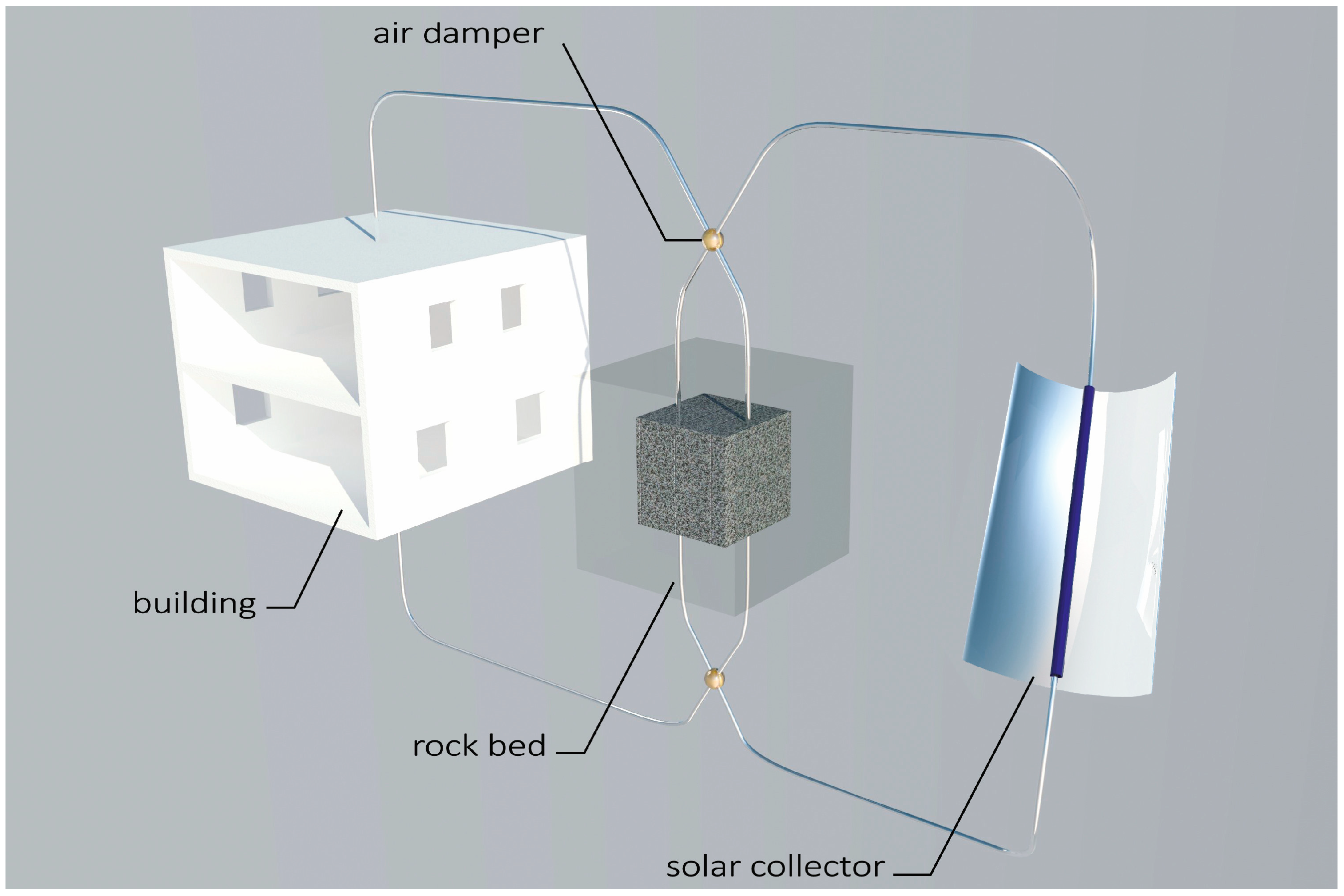
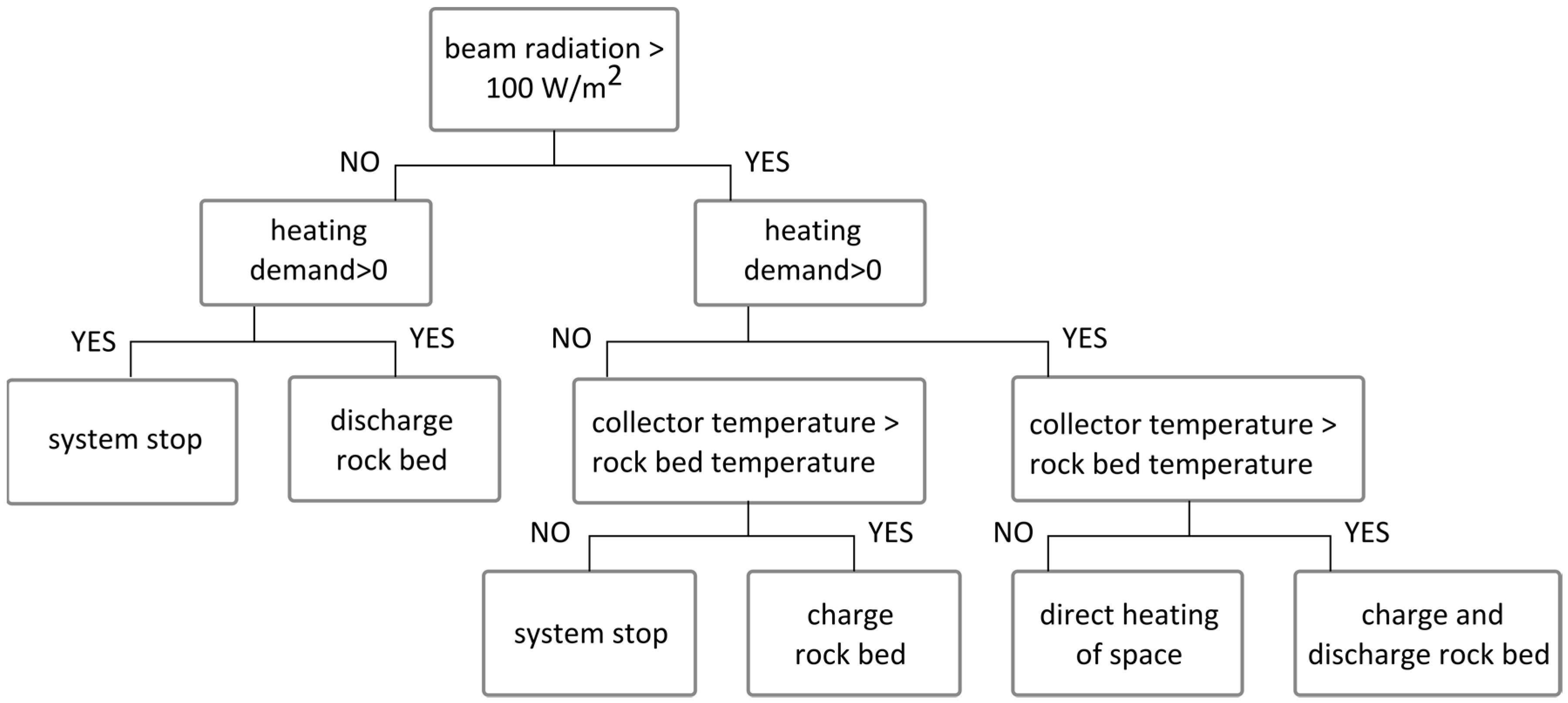

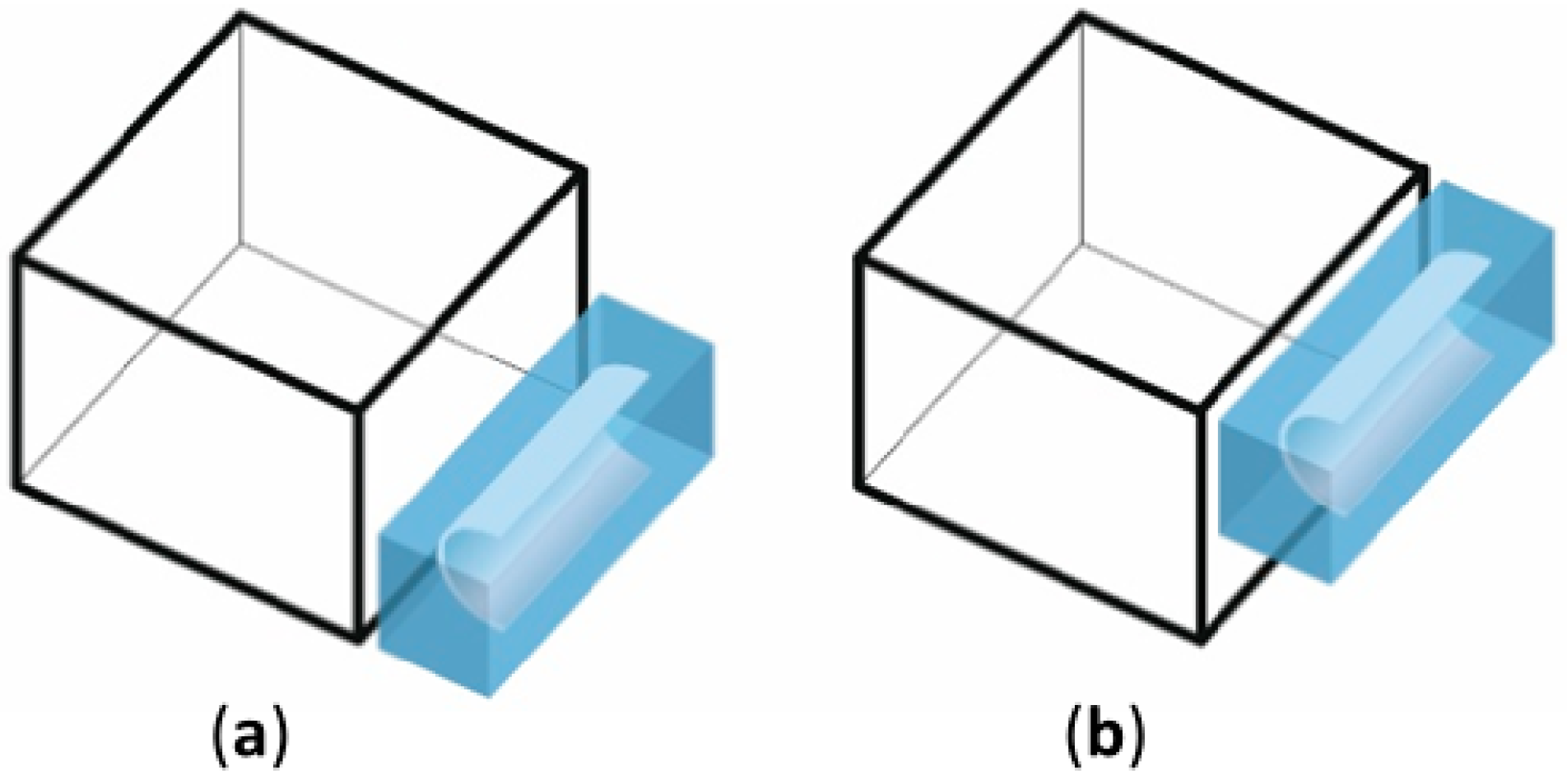












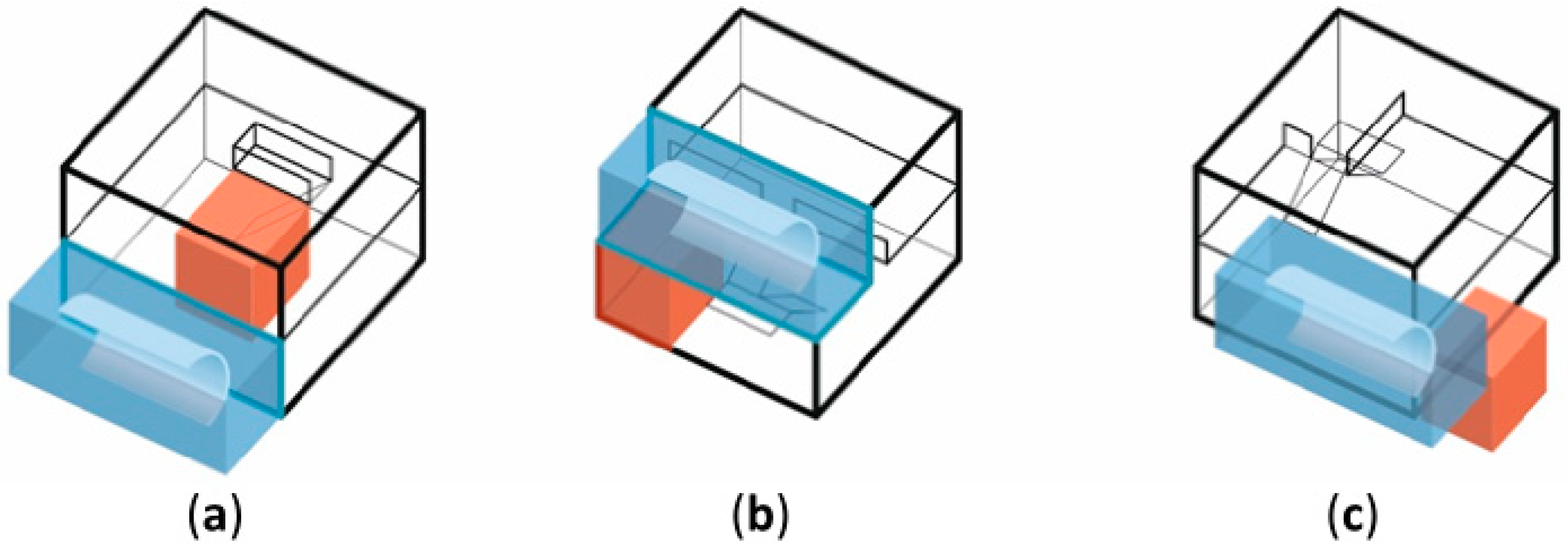
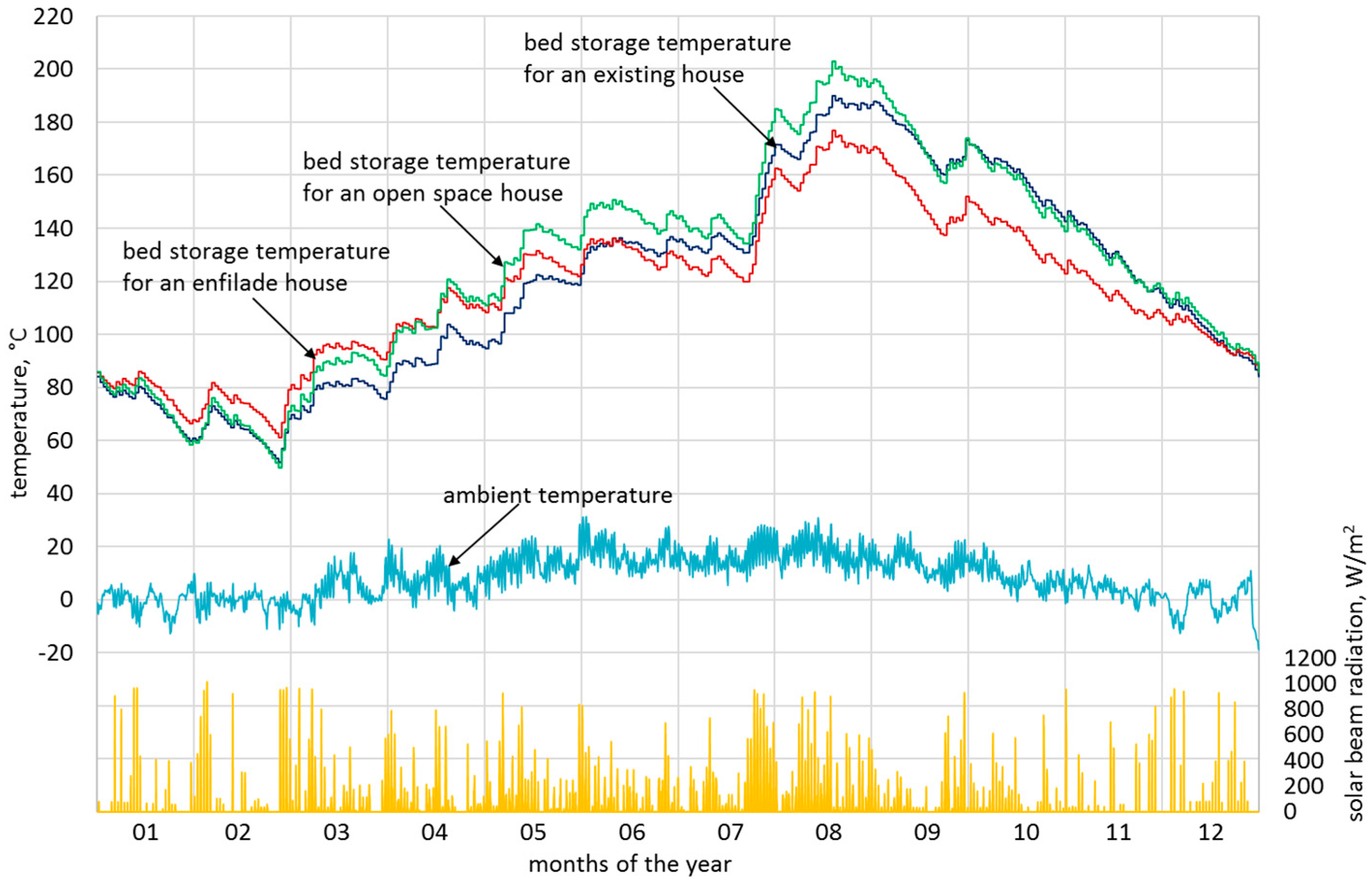
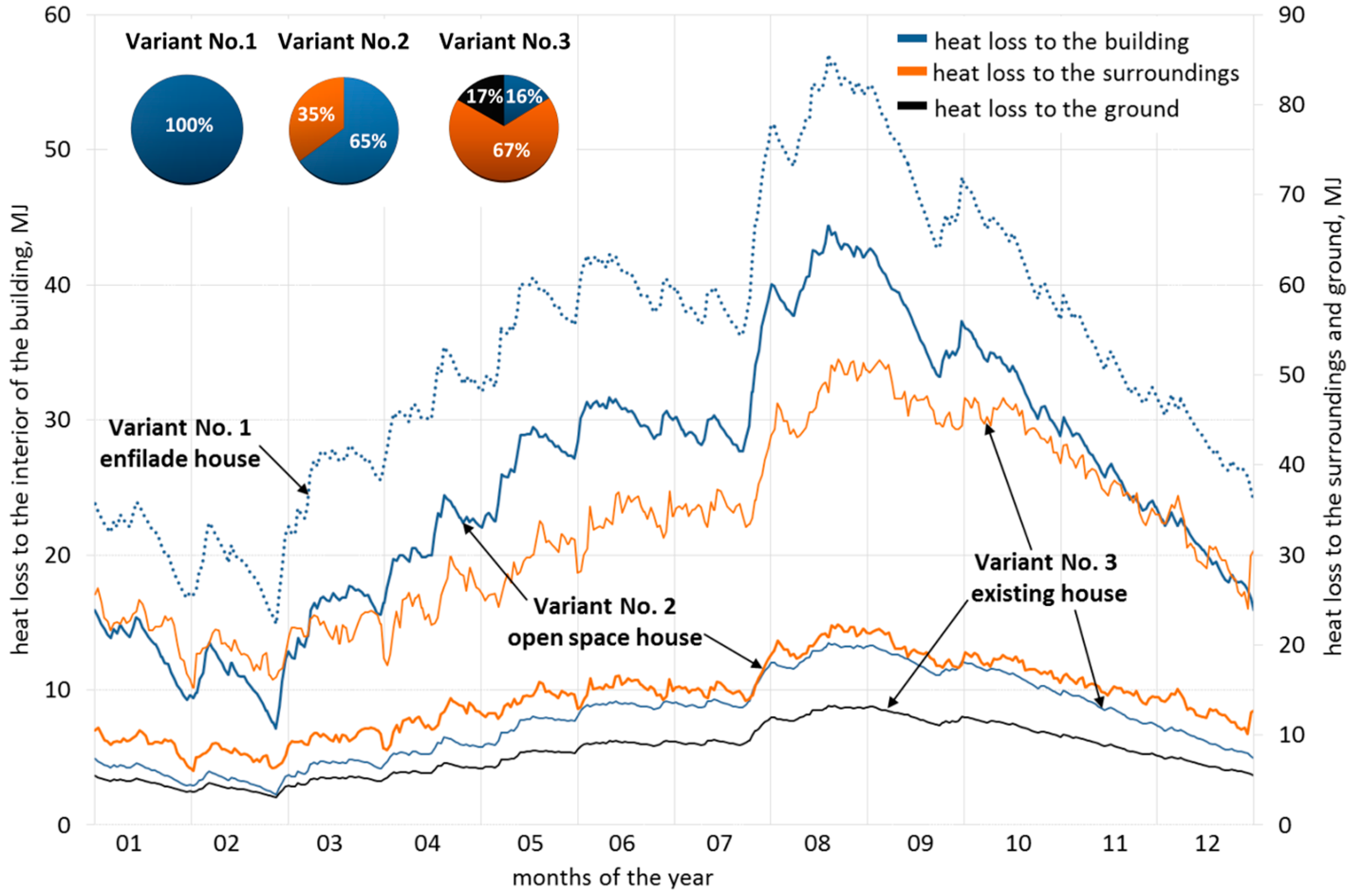
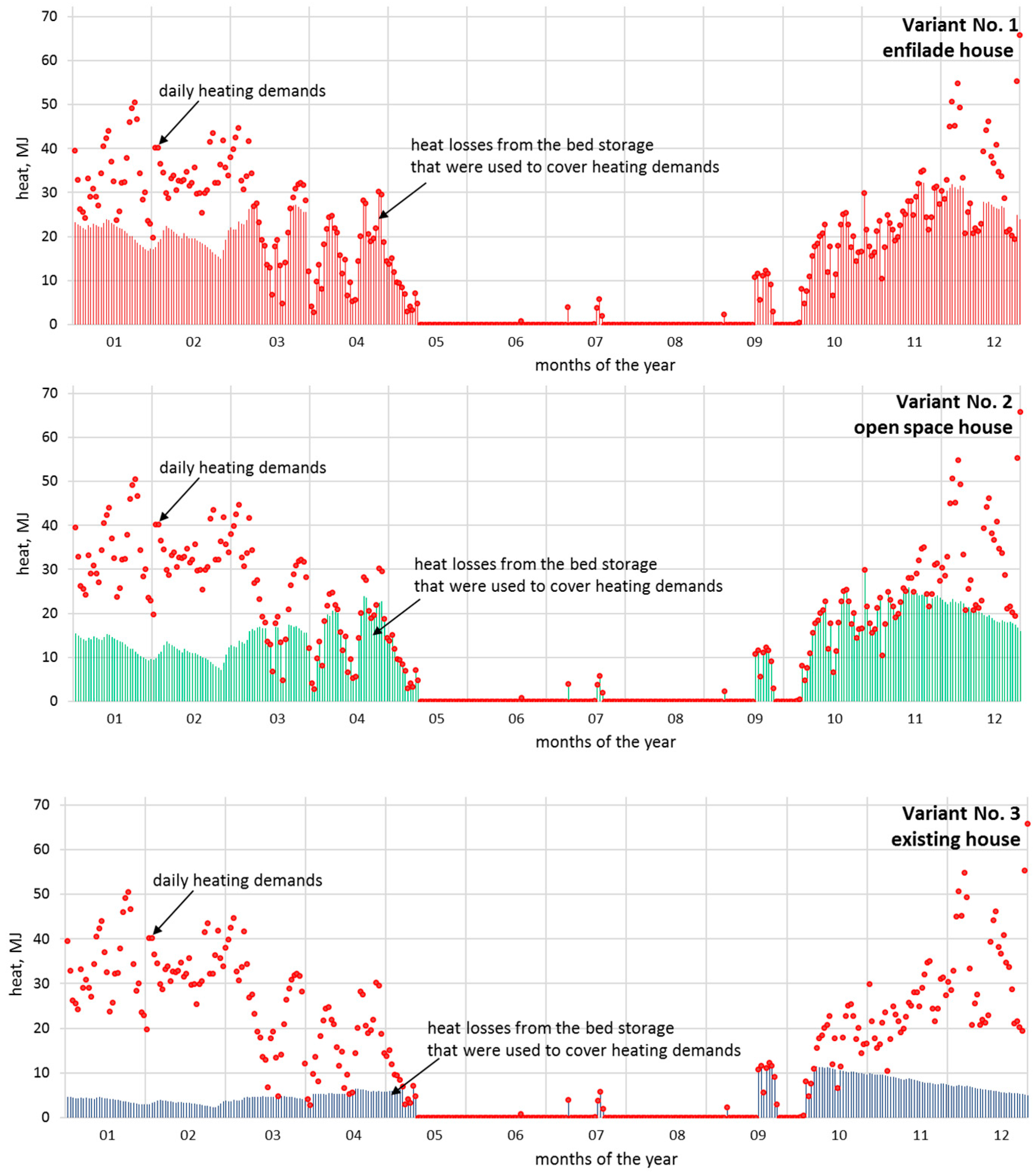

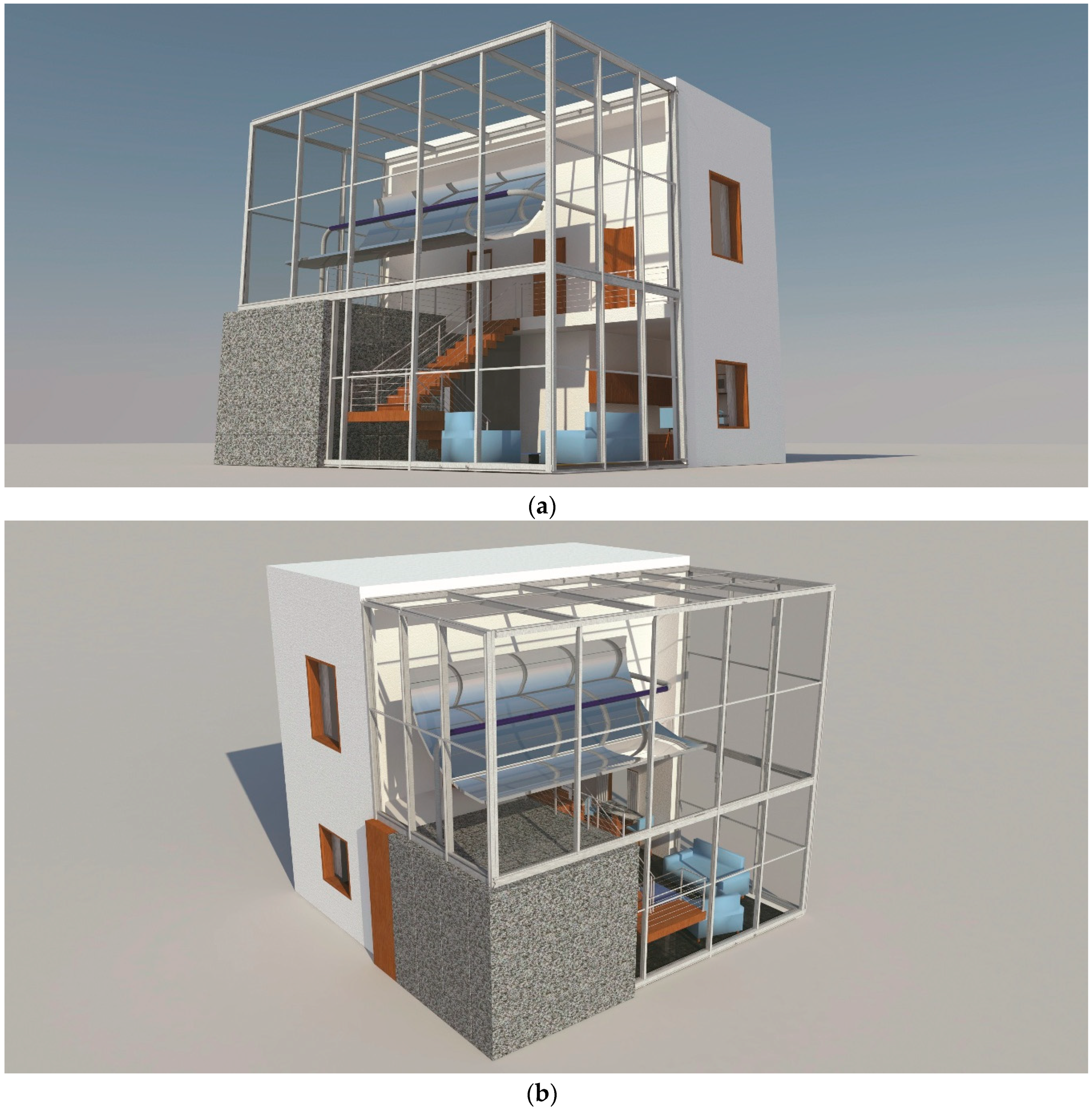
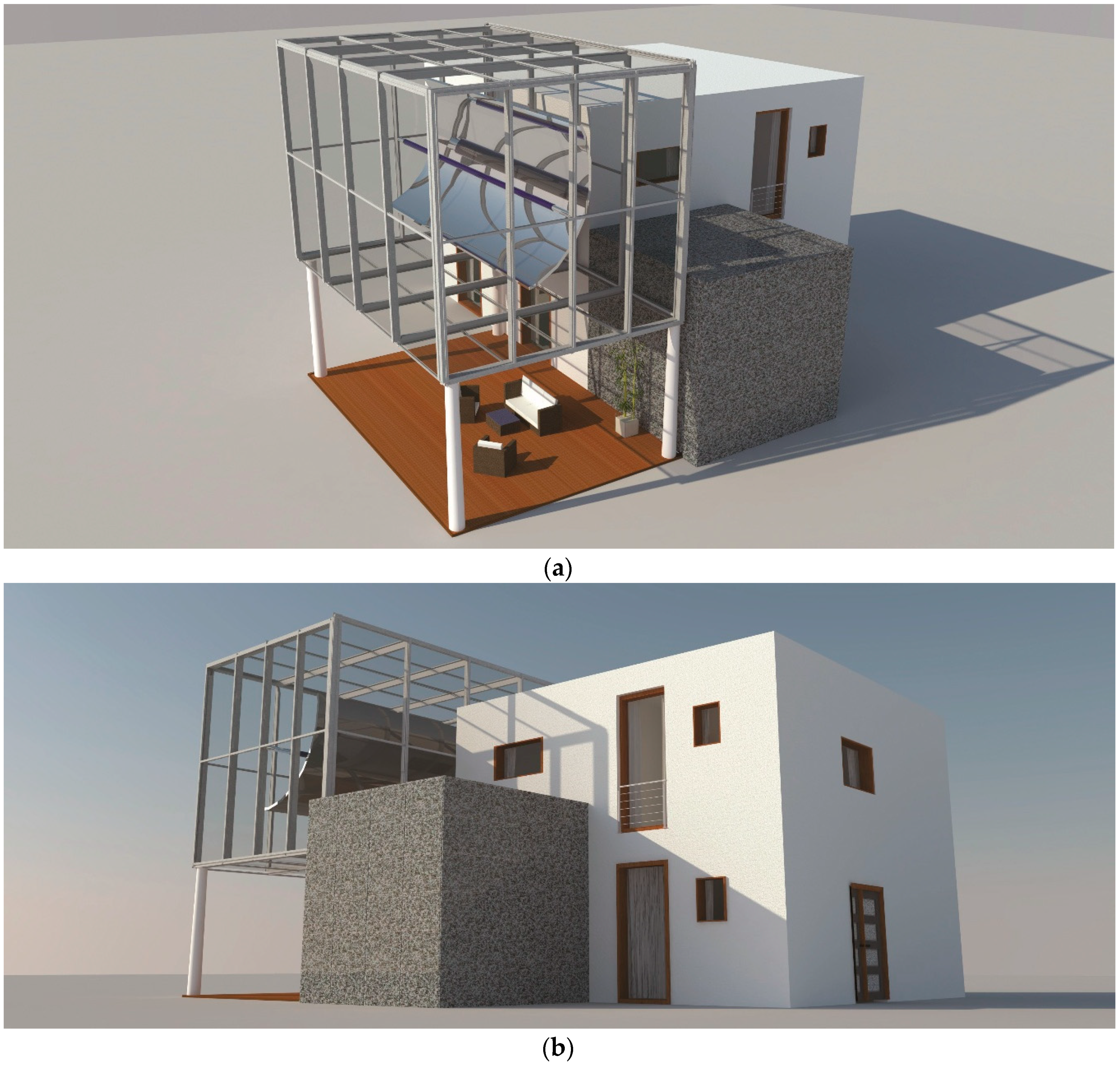
| Material | Bed Storage Filling Factor | Density | Specific Heat (Mass) | Specific Heat (Volumetric) | Material Costs | ||
|---|---|---|---|---|---|---|---|
| m3/m3 | kg/m3 | kJ/kg·K | kJ/m3·K | Euro/kg | |||
| Ceramic and construction | Ceramic brick | 0.9 | 1620 | 0.84 | 1360.8 | 0.11 | |
| Clinker brick | 0.9 | 2140 | 0.84 | 1797.6 | 0.19 | ||
| Chamotte brick | 0.9 | 2130 | 0.84 | 1789.2 | 0.39 | ||
| Hollow brick | 1.0 | 735 | 0.84 | 617.4 | 0.12 | ||
| Mineral | Cobble | Granite | 0.8 | 2800 | 0.75 | 2100.0 | 0.07 |
| Crushed | Granite | 0.7 | 2800 | 0.75 | 2100.0 | 0.01 | |
| Loose | Pebbles | 0.7 | 2700 | 0.80 | 2160.0 | 0.05 | |
| Variants of Integrating the Collector with the Building | |||||||||
|---|---|---|---|---|---|---|---|---|---|
| 1 | 2 | 3 | 4 | 5 | 6 | 7 | |||
| Model of the Variant of Integrating the Collector with the Building, according to the Numbers of Illustration | |||||||||
| Scope of Assessment | Assessment Criteria | 4a, 5a | 4b, 5b | 6a | 7d | 8a | 9a | 10c | |
| Architecture | a | A designed building | - | - | + | + | + | + | + |
| b | An existing building | + | + | - | - | - | - | - | |
| c | A small degree of integration | + | + | - | - | - | - | - | |
| d | A large degree of integration | - | - | + | + | + | + | + | |
| e | Included in the house’s solid | - | - | - | + | + | + | + | |
| f | Change in the cubature of the interior | - | - | + | - | - | + | + | |
| g | Visibility/exposure in the interior | - | - | - | + | + | + | + | |
| h | Separated construction | + | + | - | - | - | - | - | |
| Function | i | Impact on the functional and spatial system | - | - | + | - | + | + | + |
| j | Functional integration with the interior | - | - | - | + | + | + | + | |
| k | Outdoor use | - | - | - | + | + | + | + | |
| Light comfort | l | Keeping the southern exposure of basic rooms | + | + | - | + | + | + | + |
| m | Limited daylight in rooms | + | + | - | + | + | + | + | |
| Exploitation of the collector | n | Casing | + | + | + | + | + | + | - |
| o | Easy access for periodic cleaning | + | + | + | + | - | + | - | |
| Variants of Integrating the Bed Storage with the Building | |||||||||
|---|---|---|---|---|---|---|---|---|---|
| 1 | 2 | 3 | 4 | 5 | 6 | 7 | |||
| Model of the Variant of Integrating the Bed Storage with the Building, according to the Numbers of Illustration | |||||||||
| Scope of Assessment | Assessment Criteria | 11a | 12a | 12b | 13a | 13d | 15a | 16d | |
| Architecture | a | A designed building | - | + | + | + | + | + | + |
| b | An existing building | + | - | - | - | - | - | - | |
| c | A small degree of integration | + | + | + | - | - | - | - | |
| d | A large degree of integration | - | - | - | + | + | + | + | |
| e | Included in the house’s solid | - | - | - | + | + | + | + | |
| f | Under the ground | - | + | + | - | - | - | - | |
| g | Change in the cubature of the interior | - | - | - | + | + | + | + | |
| h | Neutral/invisible in the interior | + | + | + | - | - | - | - | |
| i | Visible on the ground floor | - | - | - | + | + | + | + | |
| j | Visible inside the house | - | - | - | - | - | + | + | |
| k | Exposed in the interior by a change in material | - | - | - | + | + | + | + | |
| l | Exposed outside by a change in material | + | - | - | + | - | + | + | |
| m | Spatially exposed in the interior | - | - | - | - | - | + | + | |
| Function | n | Impact on the functional and spatial system | - | - | + | + | + | + | + |
| o | Functional integration with the interior | - | - | - | - | + | + | + | |
| p | Interior use | - | - | - | - | + | + | + | |
| Light comfort | q | Keeping the southern exposure of basic rooms | + | + | - | - | + | + | + |
| r | Limited daylight in rooms | + | - | + | + | - | - | + | |
| Exploitation of the bed storage | s | Accessibility of the service zone from the outside | + | - | - | + | - | + | + |
| t | Accessibility of the service zone from the interior | - | + | - | + | + | + | + | |
| Variant | Enfilade House | Open Space House | Existing House | |
|---|---|---|---|---|
| Parameters | ||||
| Solar collector | ||||
| Mirror dimensions | 3.5 × 6 m | 4 × 6 m | 4.5 × 7 m | |
| Concentration ratio | 21.6 | 24.8 | 27.9 | |
| Working medium | Air | |||
| Mass flow rate | 0.017 kg/s | |||
| Sun tracking system | uniaxial | |||
| Concentrator | ||||
| Profiles | parabolic | |||
| Optical efficiency | 0.90 | |||
| Glass transmission | 0.88 | |||
| Reflectance | 0.85 | |||
| Absorber | ||||
| Length | 6 m | |||
| Diameter | 0.1 m | |||
| Surface coating | selective | |||
| Absorptivity | 0.96 | |||
| Emissivity | 0.12 | |||
| Fin width, height | 0.003 × 0.04 m | |||
| Number of layers | one | |||
| Glass transmission | 0.98 | |||
| Emissivity | 0.88 | |||
| Outer diameter | 0.11 m | |||
| Rock bed storage | ||||
| Dimensions | 1 × 3.5 × 4.5 m | 2.5 × 2.5 × 2.5 m | 3 × 3 × 3 m | |
| Insulation | mineral wool, 1 m thick | |||
| Mass of filling material | 29,106 kg | 28,875 kg | 49,896 kg | |
| Filling material | crushed granite | |||
| Filling factor | 0.7 | |||
© 2019 by the authors. Licensee MDPI, Basel, Switzerland. This article is an open access article distributed under the terms and conditions of the Creative Commons Attribution (CC BY) license (http://creativecommons.org/licenses/by/4.0/).
Share and Cite
Bać, A.; Nemś, M.; Nemś, A.; Kasperski, J. Sustainable Integration of a Solar Heating System into a Single-Family House in the Climate of Central Europe—A Case Study. Sustainability 2019, 11, 4167. https://doi.org/10.3390/su11154167
Bać A, Nemś M, Nemś A, Kasperski J. Sustainable Integration of a Solar Heating System into a Single-Family House in the Climate of Central Europe—A Case Study. Sustainability. 2019; 11(15):4167. https://doi.org/10.3390/su11154167
Chicago/Turabian StyleBać, Anna, Magdalena Nemś, Artur Nemś, and Jacek Kasperski. 2019. "Sustainable Integration of a Solar Heating System into a Single-Family House in the Climate of Central Europe—A Case Study" Sustainability 11, no. 15: 4167. https://doi.org/10.3390/su11154167
APA StyleBać, A., Nemś, M., Nemś, A., & Kasperski, J. (2019). Sustainable Integration of a Solar Heating System into a Single-Family House in the Climate of Central Europe—A Case Study. Sustainability, 11(15), 4167. https://doi.org/10.3390/su11154167








